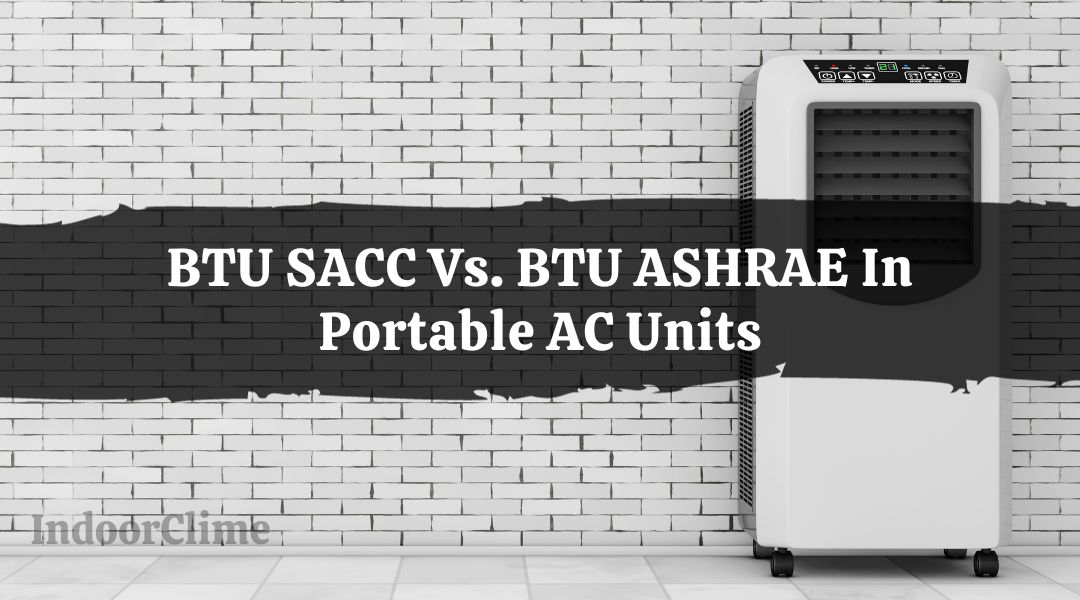When choosing a portable air conditioner, you check various metrics, but the most important is capacity. Because you need to know how powerful is a portable AC. Will it have enough power to cool your room?
But then you might stumble upon a problem because there are 2 various numbers for capacity:
BTU ASHRAE. This is an old standard measuring capacity in British Thermal Units or BTU by the American Society of Heating, Refrigerating, and Air-Conditioning Engineers.
BTU DOE or SACC/CEC. This is a new standard (since October 2017) measuring capacity in BTU by the Department Of Energy.
Please read the article to understand why there are 2 numbers, the difference, what they stand for, and how to read them.
What Does BTU ASHRAE Mean For Portable AC?
The ASHRAE rating represents how many BTUs of heat the air conditioner removes from space.
The heat the AC unit produces must be expelled from the machine by blowing air over a radiator to cool the air (much like a car does to create motion). This heat is removed using outside air by an AC unit mounted on a window or mall.
The American Society of Refrigeration and Air Conditioning Engineers measures temperature in British Thermal Units or BTUs. This is the previous standard, which we quite well understand. 80°F was the measurement temperature.
However, the warm air drawn into the space when warm air is evacuated is not considered in ASHRAE ratings for portable ACs.
A portable AC can dispel 12,000 BTU of heat every hour, but what about the 3,000 BTU it draws into the area or leaks throughout that time? As a result, only 9,000 BTUs of heat are removed on a net basis.
How Does ASHRAE Measure Portable AC Capacity?
The ASHRAE BTU test circumstances for portable air conditioners are as follows:
80°F dry bulb temperature.
67°F is the wet-bulb temperature. This translates to a relative humidity of 51%.
These bulb temperatures might seem a little challenging. However, the processes followed by ASHRAE to assess portable air conditioners are outlined in ASHRAE Standard, Method of Testing for Rating Room Air Conditioners.
The main line is that all portable air conditioners must pass an ASHRAE test under specific testing conditions. The performance of a portable AC unit is typically best in these circumstances.
The circumstances aren’t always ideal when we use a portable AC unit. However, between 75°F and 120°F, we can utilize the device.
Additionally, the relative humidity might vary from 51%. At relative humidity levels of 40%, 60%, 75%, 90%, and so on, a portable air conditioner can be used.
What Does BTU DOE or SACC/CEC Mean In Portable AC?

Seasonally Adjusted Cooling Capacity (SACC) is a rating in BTU/hour that sums up a unit’s performance in various test situations, some of which may be more extreme than the typical usage case.
The Department of Energy (DOE) adopted the Seasonally Adjusted Cooling Capacity (SACC) in 2017 as the official standard for calculating the cooling capacity of portable A/C units.
Because of the US, the devices and appliances we use daily at home must meet the minimum energy efficiency criteria the Department of Energy (DOE) sets. This applies to appliances like refrigerators, washers, and dryers.
How Does DOE Measure Portable AC Capacity?
The performance of portable air conditioners is measured in BTU/h under more realistic settings using the BTU SACC rating or Seasonally Adjusted Cooling Capacity rating.
This is an average performance across various temperatures and relative humidity levels. In addition, the effects of infiltration air are also taken into account by BTU DOE for single-hose portable air conditioners.
The following formula is used to calculate BTU SACC under the new DOE standard:
SACC is equal to (ACC95-0.2) + (ACC83-0.8).
ACC95 is a weighted measurement of the adjusted cooling capacity at 95°F dry bulb temperature.
“ACC83” refers to an adjusted cooling capacity at a dry-bulb temperature of 83°F, weighted by a factor of 0.8.
The BTU ASHRAE rating considers only one condition (80°F dry bulb, 67°F wet bulb).
The BTU SACC rating, in contrast, uses the weighted average (0.2 and 0.8 weighted factors) to account for various real-life variables while also considering two conditions (95°F dry-bulb and 83°F dry-bulb).
Converting BTU ASHRAE To BTU DOE
It is not consistently accurate, but this may give you a better idea of how to convert from BTU ASHARE to BTU DOE rating. I included the coverage area as well.
| Old ASHRAE BTU | New DOE BTU SACC | Coverage Area |
| 8,000 BTU ASHRAE | 5,000-5,500 BTU DOE | Up To 250 Sq Ft |
| 9,000 BTU ASHRAE | 5,600-6,000 BTU DOE | Up To 300 Sq Ft |
| 10,000 BTU ASHRAE | 6,100-6,800 BTU DOE | Up To 350 Sq Ft |
| 11,000 BTU ASHRAE | 6,900-7,500 BTU DOE | Up To 400 Sq Ft |
| 12,000 BTU ASHRAE | 7,600-8,200 BTU DOE | Up To 450 Sq Ft |
| 13,000 BTU ASHRAE | 8,300-8,800 BTU DOE | Up To 500 Sq Ft |
| 14,000 BTU ASHRAE | 8,900-9,500 BTU DOE | Up To 575 Sq Ft |
| 15,000 BTU ASHRAE | 9,600-10,200 BTU DOE | Up To 650 Sq Ft |
Remember that these are only estimates and can vary between various air conditioner brands and models.
Why Does Portable Air Conditioner Have Two Different BTU Ratings?
A new Federal Trade Commission (FTC) regulation mandates that portable air conditioner labels display the unique DOE and the older ASHRAE ratings.
Except for TOSOT units, this new testing is intended to reflect the energy efficiency of all portable air conditioners more appropriately.
The two ratings are different due to how a portable air conditioner operates. Although the ASHRAE rating states that our portable air conditioner has a cooling capacity of 8,000 BTU, portable air conditioners must first use some of the air from your home to chill their internal parts before releasing the now-hot air out the exhaust line.
How Does This Affect You?
The internal parts are still the same; the testing criteria for assessing how well the air conditioner will chill the space have changed.
Due to their marketing as a device that can only chill in a single room, portable air conditioners are frequently contrasted with other varieties of room air conditioners, which have a higher cooling capacity than portable air conditioner units.
You would need to buy a portable air conditioner with a BTU rating far more excellent than the BTU ratings on your window air conditioner if you wanted to buy one that could chill your room as effectively as a window air conditioner.
Why Are Both Ratings Used?
Consumers may be perplexed and believe that units marked with merely the DOE rating are less efficient than those marked with the initial ASHRAE rating because most customers are unfamiliar with the new BTU rates from the DOE.
Additionally, the Federal Trade Commission required that the new testing information be included on the yellow energy advisory labels on air conditioners and other appliances.
What Is the Difference Between ASHRAE and DOE?

While the BTU ASHRAE (American Society of Heating, Refrigerating, and Air-Conditioning Engineers) is a measure of a fuel’s heating value, the BTU DOE (Department of Energy) measures a fuel’s energy content.
The primary distinction between the two is that although the BTU ASHRAE ignores the latent heat of fuel vaporization, the BTU DOE does. Therefore, the US Department of Energy uses the BTU DOE standard because it provides a more precise indication of a fuel’s energy content.
The new DOE BTU rating (SACC) should, in principle, describe the actual power of a portable AC unit better. However, it might take some time for the DOE BTU rating to replace the outdated ASHRAE BTU standard because of its complexity.
But in reality, most HVAC professionals continue to measure portable AC performance under the outdated ASHRAE BTU standard. As a result, the old ASHRAE BTU rating rather than the new SACC BTU rating is utilized more frequently for determining the size of the air conditioner you require.
The SACC BTU rating for portable air conditioner capacity and the CEER rating were both introduced by DOE in the same document.
In the same family of metrics as the EER and SEER ratings, CEER is a measure of energy efficiency.
Application
One ton equals 12,000 BTU per hour of cooling when measuring heating and cooling power in BTUs. As a result, the US Department of Energy (DOE) determined that portable air conditioners need a rating system and developed the DOE British Thermal Unit (BTU).
Some professionals advise considering the DOE rating when selecting the best air conditioner for your space.
Before this approach, the American Society of Heating, Refrigerating, and Air-Conditioner Engineers (ASHRAE) standards were used to assess the efficiency of portable units.
These regulations were already established for window air conditioners, and both types of ACs used the same methodology.
Testing
The DOE considered that the outdated rating system had several inefficiencies peculiar to portable units, including the mixing and infiltrating of unconditioned air.
As a result, the DOE recommended new testing guidelines that use a calorimeter and a few other measurement tools to overcome these problems.
The portable window AC units must undergo a series of tests using the new testing techniques, which involve ducting and other instrumentation and monitoring the airflow.
The cooling capacity of the window and portable air conditioners is calculated in conjunction with the ANSI/ASHRAE standard.
The unit’s DOE rating is then generated using the obtained data and deductions for detected heat infiltration and humidity. The DOE rating is, therefore, often lower than the ASHRAE rating.





